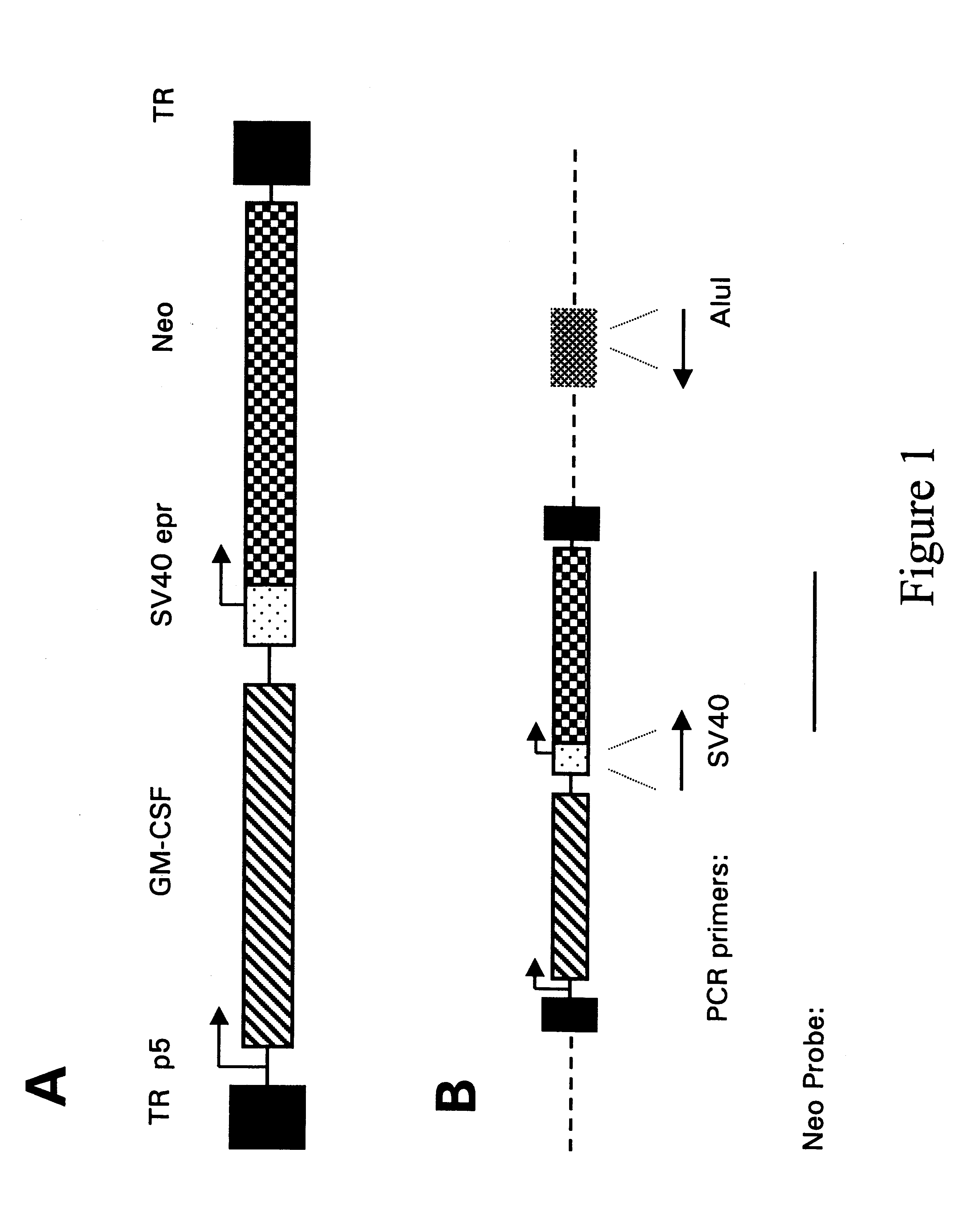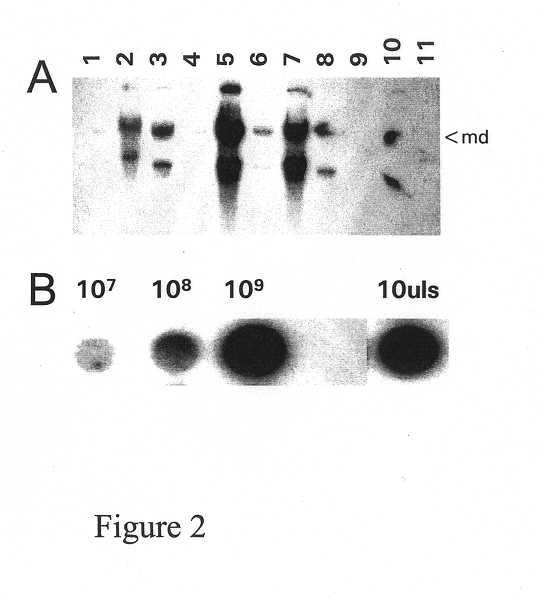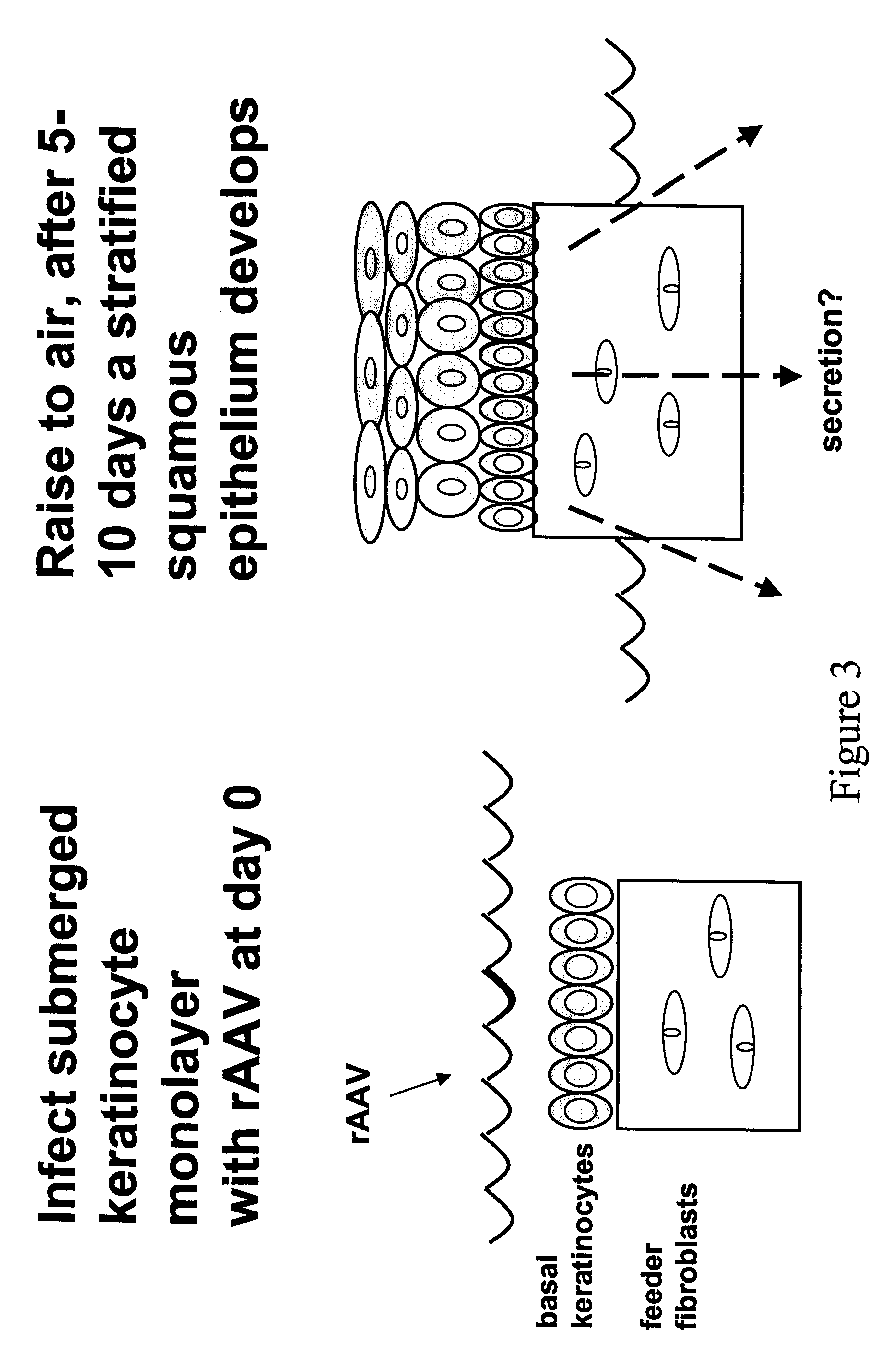Secreting products from skin by adeno-associated virus (AAV) gene transfer
a technology of adenovirus and skin, applied in the direction of viruses/bacteriophages, animal repellents, biocide, etc., can solve the problems of retrovirus use, limited effect of reaction methods, and lack of evidence of system work
- Summary
- Abstract
- Description
- Claims
- Application Information
AI Technical Summary
Problems solved by technology
Method used
Image
Examples
experiment 1
This experiment is a large experiment in which multiple variables are tested for their ability to improve AAV transduction of keratinocytes. The efficiency of rAAV transduction of general keratinocyte cultures using assays specific for marker genes alkaline phosphatases (AP), LacZ (beta-galactosidase), and GM-CSF is analyzed. Transduction levels are monitored using the well characterized histochemical assays for AP (alkaline phosphatase) and LacZ (.beta.-galactocidase) and results are scored as percent positive cells. Transduction levels for GM-CSF are measured as the amount of GM-CSF which is secreted into the medium by sandwich ELISA. The experimental variables of infection that are analyzed for improving keratinocyte transduction, include:
A) variable rAAV multiplicities of infection (MOI). Higher MOI generally result in higher transduction rates.
B) multiple rAAV infections. Multiple infections generally result in higher transduction rates.,
C) treatment of keratinoctyes with compo...
experiment 2
This experiment analyzes the efficiency of rAAV transduction of general keratinocyte cultures compared to keratinocyte stem cells sorted by .alpha.6 integrin subunit expression and small size.
Selection of keratinocyte stem cells by size. It has been reported that keratinocytes of less than 10 .mu.M have significant growth potential. These cells will be sorted from the general population. Keratinocytes are trypsinized and resuspended at a concentration of approximately 10.sup.6 / ml in Keratinocyte Serum Free Medium. Cells are sorted similar to Blantin et al (1999) (84) using FACS Vantage Cell Sorter (Becton Dickinson) cells are gated according to their forward and side scatter to the pulse width of the right angle scattered light.
A series of size sorted (10 .mu.M ) and general keratinocyte cultures (2.times.10.sup.5) in 35 mm plates are infected 10.sup.7 encapsidated genomes of AAV / AP / Neo on days 0, 1, and 2 or days 0, 2, and 4 and stained for AP activity at days 3 and 7. A series of...
experiment 3
This experiment analyzes the ability to select transduced keratinocytes (selectable marker genes Sh ble or bsd) with cytotoxic agents while maintaining growth potential with and without treatment with Amiloride (anti-differentiation).
The present invention has generated r-skin with significant secretory capabilities even without selecting for a pure population of transduced cells. However, the ability to select only successfully transduced cells would allow the generation of fully transduced keratinocyte populations and r-skin. There are a variety of resistance gene / selective agent systems available today, such as (G418 / NeomycinR gene, 1.0 kb in size (58; Zeocin / Sh ble gene (59), 0.4 kb; L-histidinol / hisD gene, 1.3 kb (46); Blasticidin / bsd gene, 0.4 kb (60); hygromycin / hygromycin-B-phosphotransferase gene / 1.3 kb). Unfortunately the grandfather selection agent, G418, stimulates terminal differentiation in primary keratinocytes (58), and in most cases, is not useful in the present inve...
PUM
 Login to View More
Login to View More Abstract
Description
Claims
Application Information
 Login to View More
Login to View More - R&D
- Intellectual Property
- Life Sciences
- Materials
- Tech Scout
- Unparalleled Data Quality
- Higher Quality Content
- 60% Fewer Hallucinations
Browse by: Latest US Patents, China's latest patents, Technical Efficacy Thesaurus, Application Domain, Technology Topic, Popular Technical Reports.
© 2025 PatSnap. All rights reserved.Legal|Privacy policy|Modern Slavery Act Transparency Statement|Sitemap|About US| Contact US: help@patsnap.com



